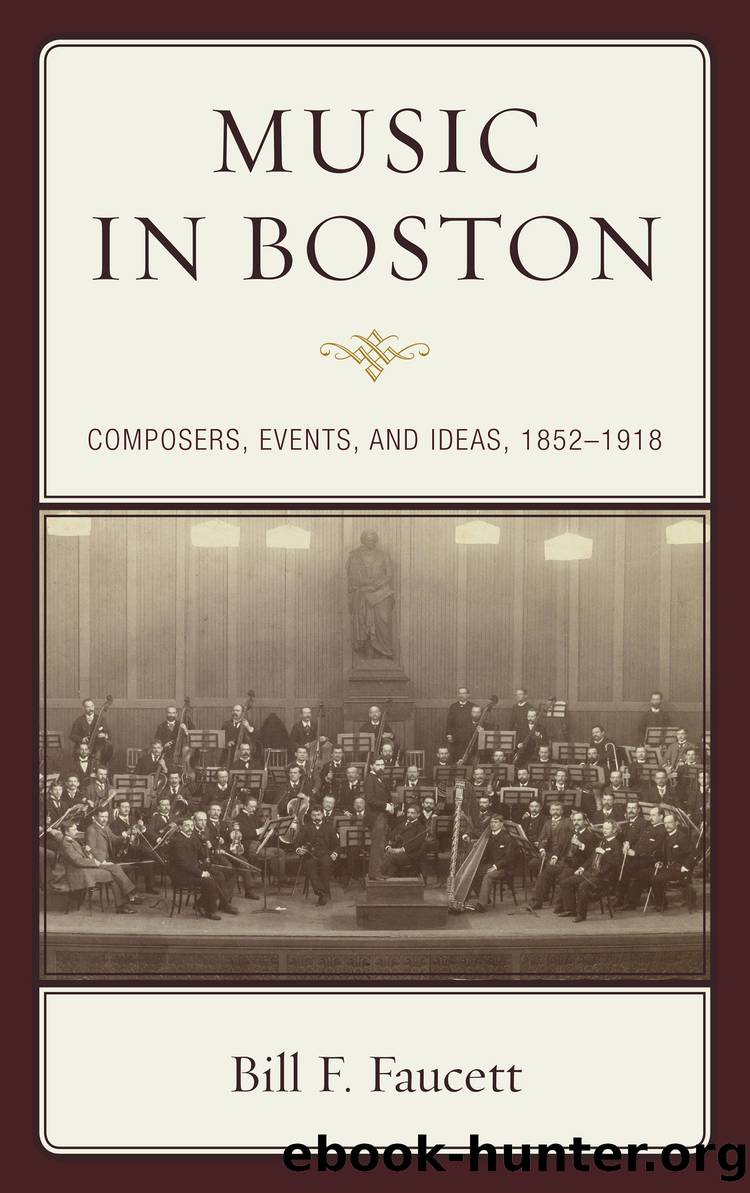Music in Boston by Faucett Bill F.;

Author:Faucett, Bill F.; [Faucett, Bill]
Language: eng
Format: epub
Publisher: Lexington Books
Published: 2016-08-15T00:00:00+00:00
Edward MacDowell: Second (Indian) Suite, op. 48 (1895)
Composed 1891-95; premiered January 23, 1896, by the Boston Symphony Orchestra, Emil Paur, conductor, at New Yorkâs Metropolitan Opera House (tour selection); published, Leipzig and New York: Breitkopf and Härtel, 1897; recorded by the Ulster Orchestra, Takuo Yuasa, conductor (Naxos 8.559075).
MacDowell began to sketch the Second (Indian) Suite, op. 48, in 1891. That was about a year after the BSOâs performance of his Lancelot and Elaine, but, importantly, well before the dedication of the buildings at the Columbian Exposition and the arrival of Dvorï´Ã¡k, both of which occurred in 1892. Unlike his music up to now, this newest work would demonstrate MacDowellâs awareness of the cultureâs restless enthusiasm to create and cultivate a music which could be identified in some sense as authentically âAmerican.â
In a move entirely at odds with his personal history and his audienceâs expectations, MacDowell elected to explore the music of various American Indian tribes. He did so with the assistance of Ãber die Musik der nordamerikanischer Wilden (On the Music of the North American Indians), an 1882 dissertation by the young German-trained American musicologist, Theodore Baker (1851â1934). As the first volume-length study of these diverse tribal musics, Bakerâs research stands as a monument of early ethnomusicological research. It also influenced countless composers who sought to sound a distinctly American voice.20
In his Indian Suite, MacDowell reverted to an earlier aesthetic that sought to establish mood, like his Hamlet and Ophelia; he did not attempt to delineate a story, as he had done in Lancelot and Elaine. MacDowell gave each of the five movements in his Suite evocative titles: âLegend,â âLove Song,â âWar Times,â âDirge,â and âVillage,â respectively.21 It is scored for piccolo; pairs of flutes, oboes, clarinets, and bassoons; four horns, two trumpets, three trombones, and a tuba; percussion including timpani, bass drum, and cymbals; and a full complement of strings.
âLegendâ (E minor; âNot fast. With much dignity and characterâ) conjures a nobility that has been commonly associated with the American Indian and starts with a powerful descending motive in the horns that permeates the movement and each subsequent one (see ex. 4.1). When the principal melody arrives, we encounter a somewhat slinky pianissimo invention that sounds in the woodwinds (mm. 38â44; 01:46), one that bears little relationship to the opening motive. A contrasting theme, in C major, occurs in the strings (m. 134; 02:27). It is a pastoral interlude, smooth and gentle, marked by an initial ascent. The Suiteâs brief development section features snippets of each of the themes heard to this point, and a prominent restatement of the secondary themeânow in the cellos in E major (m. 242; 05:32)âappears before returning to the home key. MacDowell concludes the movement with an unusually chromatic area dominated by the brasses; here he plainly borrows Lisztian sonorities as the music builds to its quadruple-forte close (mm. 274â8; 06:01).
Download
This site does not store any files on its server. We only index and link to content provided by other sites. Please contact the content providers to delete copyright contents if any and email us, we'll remove relevant links or contents immediately.
The Goal (Off-Campus #4) by Elle Kennedy(12450)
Kathy Andrews Collection by Kathy Andrews(10556)
Diary of a Player by Brad Paisley(6872)
What Does This Button Do? by Bruce Dickinson(5536)
Assassin’s Fate by Robin Hobb(5255)
Big Little Lies by Liane Moriarty(4892)
Pale Blue Dot by Carl Sagan(4018)
Sticky Fingers by Joe Hagan(3458)
The Heroin Diaries by Nikki Sixx(2942)
The Death of the Heart by Elizabeth Bowen(2910)
Beneath These Shadows by Meghan March(2730)
The Help by Kathryn Stockett(2708)
Confessions of a Video Vixen by Karrine Steffans(2682)
How Music Works by David Byrne(2537)
Jam by Jam (epub)(2496)
Harry Potter 4 - Harry Potter and The Goblet of Fire by J.K.Rowling(2422)
Strange Fascination: David Bowie: The Definitive Story by David Buckley(2371)
Petty: The Biography by Warren Zanes(2241)
Darker Than the Deepest Sea by Trevor Dann(2214)
